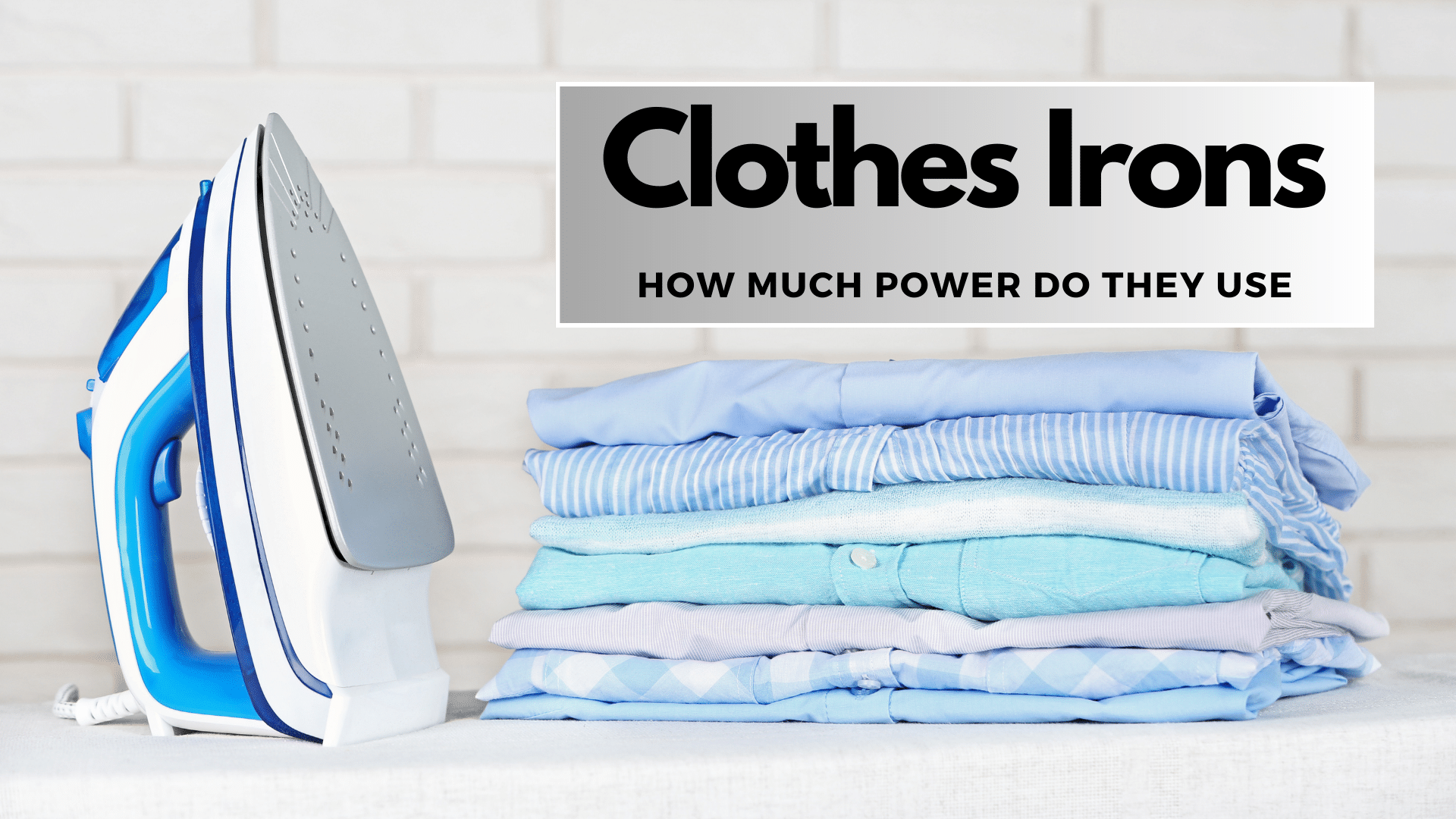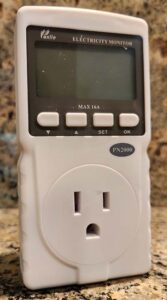Welcome to this guide on understanding how many watts an electric clothes iron uses.
In this guide, I’ll break down the concepts of watts, kilowatts, and kilowatt-hours, and explain how to calculate and measure the power consumption of an electric iron. Let’s press on!
How Many Watts Does An Iron Use?
An electric iron typically uses between 1000 and 1800 watts of power, depending on its make, model, and settings.
A higher wattage iron will heat up more quickly and generate more heat, but it will also consume more electricity.
The power rating is usually mentioned on the label or the user manual of the iron.

Table of Contents
Related Articles
- How Many Watts Does a Refrigerator Use?
- How Many Watts Does a TV Use?
- How Many Watts Does An Air Fryer Use?
How to Calculate Electric Iron Power Consumption
To calculate the power consumption of your electric iron, follow these steps:
- Find the wattage of your iron: Check the product’s label or user manual for the wattage rating.
- Convert watts to kilowatts: There are 1,000 watts in a kilowatt. Dividing the wattage by 1,000 converts watts into kilowatts (kW).
- For example, if your iron has a 1,200-watt rating, its power consumption is 1.2 kW (1200W / 1000 = 1.2kW).
- Determine usage time: Estimate the number of hours you use the iron per day (or per month).
- Calculate kilowatt-hours: Multiply the kilowatts (kW) by the number of hours of usage to get the electricity consumption in kilowatt-hours (kWh).
- For example, if you use a 1.2 kW iron for 1 hour, you consume 1.2 kWh of energy.
The average cost of one kWh of electricity in the United States was $0.11 in 2021 (the most recent year for which data is available), according to the U.S. Energy Information Administration
How to Measure Electric Iron Watt Usage
The easiest way to measure how many watts your iron uses is to plug it into an electricity usage meter. They’re inexpensive and super easy to use.
Just plug your iron into the meter and plug the meter into your wall outlet. You’ll be able to see how many watts, volts, and amps your iron is using in real-time and track electricity consumption over time.
How Much Electricity Does an Iron Use an Hour?
To calculate how much electricity an iron uses in an hour, multiply its wattage by the number of hours used and divide by 1,000.

For example, a 1200-watt iron used for 1 hour will consume 1.2 kWh of electricity
(1200 watts x 1 hour / 1000 = 1.2 kWh).
How Much Does It Cost to Use an Electric Iron for 1 Hour?
You can calculate how much it costs to use your iron by following these steps:
-
Find the cost of electricity:
Check your utility bill or contact your energy provider to determine the cost of electricity per kWh in your area.
-
Calculate energy consumption:
Calculate the energy consumption of your iron in kilowatt-hours (kWh) by following the steps in the “How to Calculate Electric Iron Power Consumption” section.
-
Determine the cost:
Multiply the energy consumption (kWh) by the cost per kWh to find the total cost of using the iron for 1 hour. For example, if the cost of electricity is $0.11 per kWh and your iron consumes 1.2 kWh, the cost would be $0.13 – (1.2 kWh x $0.11 = $0.13).
Types of Clothes Irons
There are several types of electric clothes irons, each designed for different needs and preferences. Here’s a brief overview of the most common types:
- Dry Iron: A dry iron is the most basic type of iron, with a flat soleplate that heats up when plugged in. It doesn’t have any steam generating features, so you’ll need to sprinkle water on the clothes manually to help remove wrinkles. Dry irons are generally affordable and lightweight.
- Steam Iron: Steam irons have a built-in water tank and produce steam when heated. The steam is released through small holes in the soleplate, helping to relax fabric fibers and remove wrinkles more effectively than dry irons. Steam irons usually have variable temperature and steam settings, making them suitable for various fabric types.
- Vertical Steam Iron: Also known as a garment steamer, a vertical steam iron is designed to release steam vertically and be used on hanging clothes or curtains. These irons are suitable for delicate fabrics that are difficult to iron on a traditional ironing board, such as silk or velvet.
- Cordless Iron: A cordless iron offers greater freedom of movement and convenience, because you don’t have to worry about the power cord getting in the way while ironing. These irons have a charging base that heats the iron, and they retain heat while you iron. The trade off for the cordless advantage is that you may need to recharge the iron frequently, depending on the iron’s design and battery capacity.
- Travel Iron: Travel irons are compact, lightweight, and designed for people who travel. Some travel irons have foldable handles and dual voltage compatibility for use internationally. However, their small size and lower wattage may make them less effective at removing wrinkles compared to full-sized irons.
- Ironing Press: An ironing press, also known as a steam press, is a large, clamshell-like appliance that uses heat and pressure to iron clothes quickly and efficiently. Iron presses are ideal if you need to iron large quantities of clothes or linens. They are more expensive and take up more space than traditional irons.
Clothes Iron Power Usage by Type
The power consumption of electric clothes irons varies depending on the type, size, and features of the iron. Here’s an overview of the typical power consumption needs for each type:
- Dry Iron: Dry irons generally have a power rating between 1000 and 1200 watts. Their power consumption is lower compared to steam irons because they do not have to boil water to generate steam.
- Steam Iron: A typical steam iron uses between 1200 and 1800 watts, with the more power hunger units often provding more features.
- Vertical Steam Iron: Vertical steam irons, or garment steamers, commonly have a power rating between 800 and 1800 watts, with professional-grade models may consume even more power.
- Cordless Iron: Cordless irons typically have a power rating similar to traditional steam irons, ranging from 1200 to 1800 watts. However, their actual power consumption may be lower since they are only heating up while on the charging base.
- Travel Iron: Travel irons, primarily due to their compact size and portability, have a lower power rating, usually between 800 and 1200 watts. .
- Ironing Press: Ironing presses consume a significant amount of power, with wattage ratings ranging from 1000 to 2400 watts and higher for professional-grade models.
Common Electric Clothes Iron Watt Ratings
| Iron Type | Common Wattage |
|---|---|
| Dry Iron | 1,000 to 1,200 Watts |
| Steam Iron | 1,200 to 1,800 Watts |
| Vertical Steam Iron | 800 to 1,800 Watts |
| Cordless Iron | 1,200 to 1,800 Watts |
| Travel Iron | 800 to 1,200 Watts |
| Ironing Press | 1,000 to 2,400 Watts |
Keep in mind that these power consumption values are approximate and can vary depending on the specific make and model of each iron.
Ways To Save Electricity When Using a Clothes Iron
There are several ways to save electricity when using a clothes iron. Implementing these practices can help reduce your energy consumption and lower your electricity bill:
- Select the right iron: Choose an iron with a higher wattage rating, as it heats up faster and requires less time to reach the desired temperature, which can save energy in the long run.
- Use the right temperature setting: Always set your iron to the appropriate temperature for the fabric you’re ironing. Higher temperatures consume more energy, so using the correct setting can help save electricity.
- Sort your clothes: Iron clothes with similar fabric types together, starting with those requiring lower temperatures and moving to those needing higher temperatures. This way, you avoid constantly adjusting the temperature settings, which can save energy.
- Iron damp clothes: Slightly damp clothes are easier to iron, and you’ll need less heat to remove wrinkles. If your clothes are dry, use a spray bottle to dampen them slightly before ironing.
- Use a reflective ironing board cover: A reflective ironing board cover helps to reflect heat back onto the clothes, reducing the amount of time and energy needed to iron them.
- Keep the iron’s soleplate clean: A clean soleplate allows the iron to glide smoothly and distribute heat evenly, which can help save energy by reducing the time spent ironing.
- Turn off the steam function when not needed: If you’re using a steam iron, turn off the steam function when ironing fabrics that don’t require it. Generating steam consumes extra energy, so using it only when necessary can help save electricity.
- Unplug the iron when not in use: Don’t leave your iron plugged in and switched on when you’re not using it, as it continues to consume energy. Unplug it as soon as you’re done ironing.
- Iron larger batches at once: Instead of ironing small batches of clothes throughout the week, save up and iron a larger batch in one go. This way, the iron is only heated once, reducing energy consumption.
By following these tips, you can save energy and reduce your electricity consumption when using a clothes iron.
FAQs
Here are some common FAQs related to energy consumption and clothes irons:
Does a higher wattage iron consume more electricity?
Yes, a higher wattage iron consumes more electricity than a lower wattage iron. However, it heats up faster and can iron clothes more efficiently, potentially saving time and energy overall.
Can I save energy by ironing at a lower temperature?
Yes, ironing at a lower temperature can save energy, but it’s essential to use the appropriate temperature for the fabric you’re ironing. Using a temperature too low for the fabric may require you to spend more time ironing, which could negate any energy savings.
How much energy does a steam iron use compared to a dry iron?
Steam irons generally consume more energy than dry irons because they need to heat water to generate steam. The difference in energy consumption depends on the specific watt ratings of the irons being compared.
What size portable power station do I need to run an iron?
If you need a portable power station that can power your electric clothes iron, you need to consider the iron’s watt rating and the power station’s output capacity. Portable power stations typically have output ratings in watts or watt-hours. For example, in order to run a 1200-watt iron, you would need a power station with an output capacity of at least 1200 watts.
What is a good wattage for a steam iron?
A good wattage for a steam iron typically ranges between 1400 and 1800 watts. Steam irons with higher wattages heat up faster and provide better steam output, which can help remove wrinkles more effectively and reduce ironing time, saving energy in the process.
